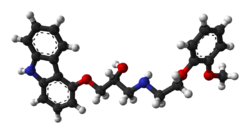 | |
 | |
| Clinical data | |
|---|---|
| Trade names | Coreg, others |
| Other names | BM-14190 |
| AHFS/Drugs.com | Monograph |
| MedlinePlus | a697042 |
| License data |
|
| Routes of administration | By mouth |
| ATC code | |
| Legal status | |
| Legal status |
|
| Pharmacokinetic data | |
| Bioavailability | 25–35% |
| Protein binding | 98% |
| Metabolism | Liver (CYP2D6, CYP2C9) |
| Elimination half-life | 7–10 hours |
| Excretion | Urine (16%), feces (60%) |
| Identifiers | |
| |
| CAS Number | |
| PubChem CID | |
| IUPHAR/BPS | |
| DrugBank | |
| ChemSpider | |
| UNII | |
| KEGG | |
| ChEBI | |
| ChEMBL | |
| PDB ligand | |
| CompTox Dashboard (EPA) | |
| ECHA InfoCard | 100.117.236 |
| Chemical and physical data | |
| Formula | C24H26N2O4 |
| Molar mass | 406.482 g·mol−1 |
| 3D model (JSmol) | |
| Chirality | Racemic mixture |
| |
| |
| (verify) | |
Carvedilol, sold under the brand name Coreg among others, is a beta blocker medication, that may be prescribed for the treatment of high blood pressure (hypertension) and chronic heart failure with reduced ejection fraction (also known as HFrEF or systolic heart failure).[1][2] Beta-blockers as a collective medication class are not recommended as routine first-line treatment of high blood pressure for all patients, due to evidence demonstrating less effective cardiovascular protection and a less favourable safety profile when compared to other classes of blood pressure-lowering medications.[1][3][4]
Common side effects include dizziness, tiredness, joint pain, low blood pressure, nausea, and shortness of breath.[5] Severe side effects may include bronchospasm.[5] Safety during pregnancy or breastfeeding is unclear.[6] Use is not recommended in those with liver problems.[7] Carvedilol is a nonselective beta blocker and alpha-1 blocker.[5] How it improves outcomes is not entirely clear but may involve dilation of blood vessels.[5]
Carvedilol was patented in 1978 and approved for medical use in the United States in 1995.[5][8] It is on the World Health Organization's List of Essential Medicines.[9] It is available as a generic medication.[5] In 2022, it was the 34th most commonly prescribed medication in the United States, with more than 17 million prescriptions.[10][11]
- ^ a b Mancia G, Kreutz R, Brunström M, Burnier M, Grassi G, Januszewicz A, et al. (December 2023). "2023 ESH Guidelines for the management of arterial hypertension The Task Force for the management of arterial hypertension of the European Society of Hypertension: Endorsed by the International Society of Hypertension (ISH) and the European Renal Association (ERA)". Journal of Hypertension. 41 (12): 1874–2071. doi:10.1097/HJH.0000000000003480. hdl:11379/603005. PMID 37345492.
- ^ McDonagh TA, Metra M, Adamo M, Gardner RS, Baumbach A, Böhm M, et al. (September 2021). "2021 ESC Guidelines for the diagnosis and treatment of acute and chronic heart failure". European Heart Journal. 42 (36): 3599–3726. doi:10.1093/eurheartj/ehab368. PMID 34447992.
- ^ Wei J, Galaviz KI, Kowalski AJ, Magee MJ, Haw JS, Narayan KM, et al. (February 2020). "Comparison of Cardiovascular Events Among Users of Different Classes of Antihypertension Medications: A Systematic Review and Network Meta-analysis". JAMA Network Open. 3 (2): e1921618. doi:10.1001/jamanetworkopen.2019.21618. PMC 7043193. PMID 32083689.
- ^ Bangalore S, Parkar S, Grossman E, Messerli FH (October 2007). "A meta-analysis of 94,492 patients with hypertension treated with beta blockers to determine the risk of new-onset diabetes mellitus". The American Journal of Cardiology. 100 (8): 1254–1262. doi:10.1016/j.amjcard.2007.05.057. PMID 17920367.
- ^ a b c d e f "Carvedilol Monograph for Professionals". Drugs.com. AHFS. Retrieved 24 December 2018.
- ^ "Carvedilol Use During Pregnancy". Drugs.com. Retrieved 24 December 2018.
- ^ British national formulary : BNF 76 (76 ed.). Pharmaceutical Press. 2018. p. 147. ISBN 9780857113382.
- ^ Fischer J, Ganellin CR (2006). Analogue-based Drug Discovery. John Wiley & Sons. p. 463. ISBN 9783527607495.
- ^ World Health Organization (2023). The selection and use of essential medicines 2023: web annex A: World Health Organization model list of essential medicines: 23rd list (2023). Geneva: World Health Organization. hdl:10665/371090. WHO/MHP/HPS/EML/2023.02.
- ^ "The Top 300 of 2022". ClinCalc. Archived from the original on 30 August 2024. Retrieved 30 August 2024.
- ^ "Carvedilol Drug Usage Statistics, United States, 2013 - 2022". ClinCalc. Retrieved 30 August 2024.